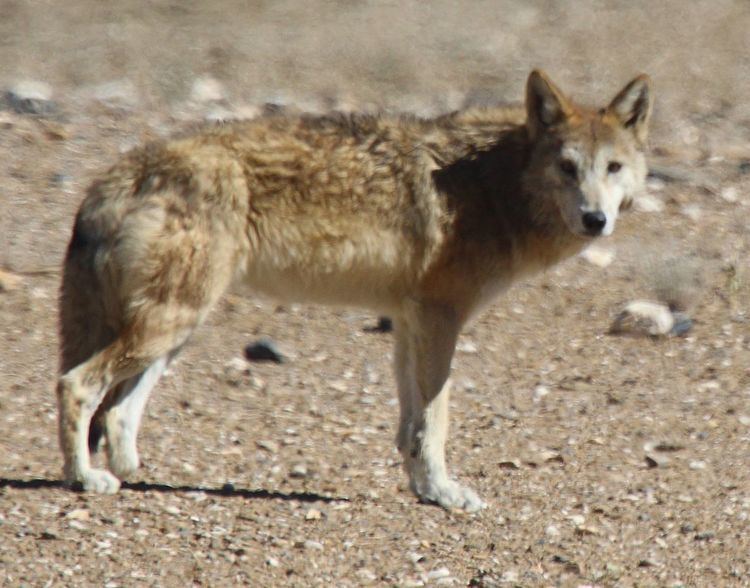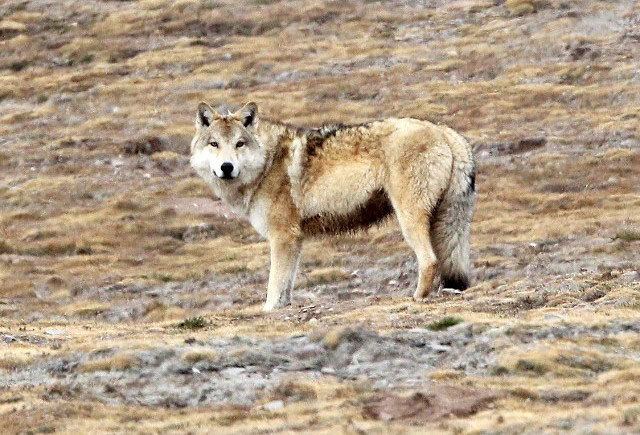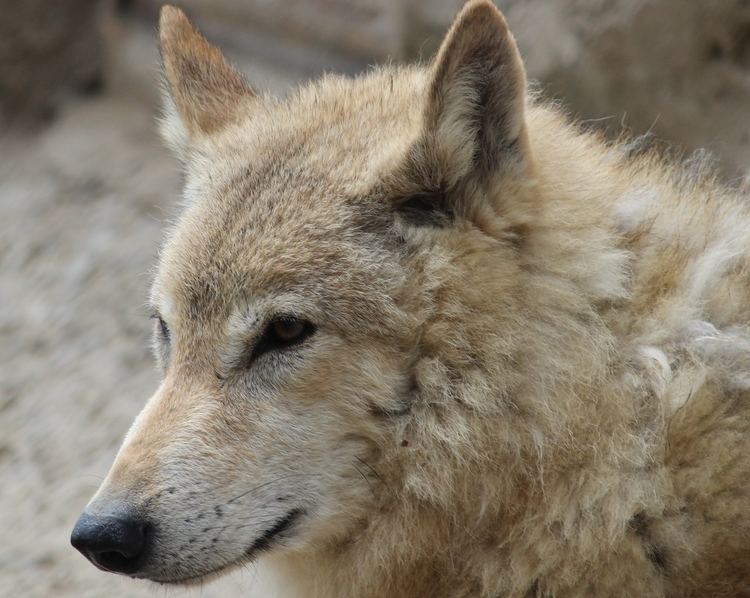Kingdom Animalia Order Carnivora Genus Canis Higher classification Gray wolf | Phylum Chordata Family Canidae Scientific name Canis lupus chanco Rank Subspecies | |
 | ||
Similar Gray wolf, Canidae, Arctic wolf, Canis, Mammal | ||
Tibetan wolf facts
The Tibetan wolf (Canis lupus filchneri) is a subspecies of the gray wolf that is native to China in the regions of Gansu, Qinghai, and Xichang (Tibet). It is found in northern India in the Ladakh region of eastern Kashmir, and the Lahaul and Spiti region in the northeastern part of Himachal Pradesh. It is also found in Nepal in the Upper Dolpa and Upper Mustang regions. Its taxonomic classification is sometimes referred to by its previous classification of Canis lupus laniger, and sometimes incorrectly as Canis lupus chanco (the Mongolian wolf).
Contents
- Tibetan wolf facts
- Tibetan wolf really close
- Taxonomy
- Lineage
- Physical description
- Distribution and habitat
- Relationship with humans
- Himalayan wolf
- References

Tibetan wolf really close
Taxonomy

The wolves of Tibet were first described by British zoologist Brian Houghton Hodgson in 1847 as Canis lupus laniger.

In 1907, the German zoologist Paul Matschie described a type specimen of a wolf that lived in the Gansu and Qinghai regions of China, which he named Canis filchneri Matschie (1907). Wilhelm Filchner was a German explorer who led an expedition from China to Tibet in 1903-1905 and the wolf was named by Matschie in his honor. In the third edition of Mammal Species of the World published in 2005, the mammalogist W. Christopher Wozencraft listed under the wolf Canis lupus the taxonomic synonyms for the subspecies Canis lupus filchneri, under which he included filchneri Matschie (1907) and laniger Hodgson (1847).

There remains taxonomic confusion over the Tibetan wolf. In 1941, Reginald Pocock had referred to the Tibetan wolf as Canis lupus laniger and classified it as a synonym under C. l. chanco. There are some researchers who still refer to Pocock's classification of the Tibetan wolf as C. l. chanco, which has caused taxonomic confusion. The NCBI/Genbank lists Canis lupus laniger as the Tibetan wolf, and separately Canis lupus chanco as the Mongolian wolf. Additionally, there are recent academic works that still refer to the Tibetan wolf as C. l. laniger.
Lineage
In 2011, a genetic study found that the Tibetan wolf might be an archaic pedigree within the wolf species. In 2013, a major study looked at the DNA sequences of dogs and wolves and was intending to include 2 Tibetan wolves but then:
excluded two aberrant modern wolf sequences from this analysis since their phylogenetic positioning suggests only a distant relationship to all extant gray wolves and their taxonomic classification as a member of Canis lupus or a separate sub-species is a matter of debate.
In 2014, a sequence of the entire mitochondrial genome of the Tibetan wolf found that its MT-ND4L gene commenced with the base pairs GTG, whereas all other canids commence with ATG. A 2016 study sequenced the whole genome of wolves and dogs throughout the world, and found that the phylogenetic tree generated from the sequences was more easily resolved with the removal of the "two outlier" Tibet and Qinghai specimens. The Tibet population had shown decline over the past 25,000 years, however the Qinghai population had shown growth. The Qinghai population exhibited gene flow to the ancestor of the Dingo lineage of 0.3%, and showed gene flow from Chinese indigenous dogs of 16%. The specimens from Tibet were the most genetically divergent wolf population in this study. The wolf's lineage had suffered a historical population bottleneck having only recently recolonized the Tibetan Plateau. Glaciation during the Last Glacial Maximum may have caused its habitat loss, genetic isolation then local adaptation, and there was evidence of ancient inbreeding. The study proposes that these are the reasons that the wolves from Tibet were the most genetically distinct. Later in 2016, a study compared wolf mitochondrial DNA sequences of 582 base pairs in length. The phylogenetic tree generated from the sequences revealed that the two most basal clades were formed by specimens from India and the Himalayas (this classification included specimens from Tibet as well as from the Himalayas for the purpose of this study). Within the Himalayan/Tibetan wolf clade also fell some specimens from China and Mongolia, indicating a common maternal ancestor and a wider genetic distribution.
Physical description
Hodgson described his type specimen as follows:
Lupus laniger. The Changu of the Tibetans. Hab. Tibet. Wolf with long sharp face, elevated brows, broad head, large pointed ears, thick woolly pilage, and very full brush of medial length. Above, dull earthy-brown; below, with the entire face and limbs yellowish-white. No marks on the limbs. Tail concolorous with the body, that is brownish above and yellowish below, and no dark tip. Length 45 in (110 cm). Height 30 in (76 cm). This animal is found all over Tibet.
The British naturalist Richard Lydekker wrote in 1900:
In order to withstand the intense winter cold of the bleak altitudes of which it dwells, and at the same time to harmonise with its physical surroundings, the wolf of Ladak and Tibet has developed a woolly character in its fur, and at the same time has become a much paler animal than ordinary examples of the European race.
The British zoologist Thomas C. Jerdon wrote in 1874 that the Tibetan wolf is larger than the Indian Wolf and known as "chankodi" among the people who live near the Niti Pass on the Tibet/Indian border (Kumaon District, India). Black wolves in Tibet are known locally as "chanko nagpo", and these are considered bolder and more aggressive than the pale coloured variety.
Distribution and habitat
The Tibetan wolf is native to China in the regions of Gansu, Qinghai, and Xichang (Tibet). It is found in northern India in the Ladakh region of eastern Kashmir and the Lahaul and Spiti region in the northeastern part of Himachal Pradesh. It is also found in Nepal in the Upper Dolpa and Upper Mustang regions.
Between 2005 and 2008, sightings and scat of Tibetan wolves were recorded in the alpine meadows above the tree line north-east of the Nanda Devi National Park in Uttarakhand, India. In 2013, the media reported that a Tibetan wolf was photographed by a camera trap installed at about 3,500 m (11,500 ft) altitude near the Sunderdhunga Glacier in Bageshwar district, Uttarakhand, India.
Relationship with humans
Historical sources indicate that wolves occasionally killed children in Ladakh and Lahoul. Within the proposed Gya-Miru Wildlife Sanctuary in Ladakh, the intensity of livestock depredation was assessed in three villages. The assessment found that Tibetan wolves were the most important predators accounting for 60% of the total livestock losses, followed by the snow leopard and Eurasian lynx. The most frequent prey were Domestic goats (32%), followed by sheep (30%), yaks (15%), and horses (13%). The wolves killed horses significantly more, and goats less, than would be expected from their relative abundance.
Himalayan wolf
The Himalayan wolf is a proposed clade within the Tibetan wolf that is distinguished by its mitochondrial DNA, which is basal to all other wolves including other Tibetan wolves. DNA sequences can be mapped to reveal a phylogenetic tree that represents evolutionary relationships, with each branch point representing the proposed divergence of two lineages from a common ancestor. "The term basal taxon refers to a lineage that diverges early in the history of the group and lies on a branch that originates near the common ancestor of the group." Two DNA studies in 2004 and 2007 found that some of the Tibetan wolves living in the Trans-Himalaya region were basal to all other wolves, and proposed a new taxonomic classification of Canis himalayensis. This classification is disputed.
Two later studies compared sequences from the wolves of the Himalayas against world-wide wolf sequences and confirmed their basal position, however these studies did not include wolves from Tibet. Later in 2016, a study compared wolf mitochondrial DNA sequences of 582 base pairs in length. The phylogenetic tree generated from the sequences revealed that the two most basal clades were formed by specimens from India and the Himalayas (the "Himalayas" classification included specimens from Tibet as well as from the Himalayas for the purpose of this study). Within the Himalayan/Tibetan wolf clade also fell some specimens from China and Mongolia, indicating a common maternal ancestor and a wider genetic distribution.
The proposed Himalayan wolf is found in northern India in the Ladakh region of eastern Kashmir and the Lahaul and Spiti region in the northeastern part of Himachal Pradesh. It is also found in Nepal in the Upper Dolpa and Upper Mustang regions. A population of them can also be found in Tibet. The Indian population consists of 350 wolves with a range of 70,000 km2 (27,000 sq mi).
